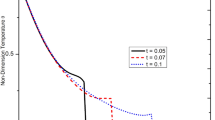Abstract
We formulate integral statements of force balance, energy balance, and entropy imbalance for an interface between a body and its environment. These statements account for interfacial energy, entropy, and stress but neglect the inertia of the interface. Our final results consist of boundary conditions describing thermomechanical interactions between the body and its environment. In their most general forms, these results are partial differential equations that account for dissipation and encompass as special cases Navier’s slip law, Newton’s law of cooling, and Kirchhoff’s law of radiation. When dissipation is neglected, our results reduce to the well-known zero-slip, free-surface, zero-shear, prescribed temperature, and flux-free conditions.
Similar content being viewed by others
References
Capriz G. and Podio-Guidugli P. (2005). Whence the boundary conditions in modern continuum physics?. Atti. Dei. Convegni. Lincei. 210: 19–42
Kleinstein G.G. (2005). On the derivation of boundary conditions fom the global principles of continuum mechanics. Q. Appl. Math. 63: 469–478
Cermelli P., Fried E. and Gurtin M.E. (2005). Transport relations for surface integrals arising in the formulation of balance laws for evolving fluid interfaces. J. Fluid Mech. 544: 339–351
Slattery J.C. (1972). Momentum, Energy and Mass Transfer in Continua. McGraw-Hill, New York
Slattery J.C. (1990). Interfacial Transport Phenomena. Springer, New York
Phillips H.B. (1933). Vector Analysis. Wiley, New York
Aris R. (1989). Vectors, Tensors and the Basic Equations of Fluid Mechanics. Dover, New York
Gurtin, M.E., Murdoch, A.I.: A continuum theory of elastic material surfaces. Arch. Rational Mech. Anal. 57, 291–323 (1975) Addenda 59, 389–390 (1975)
Scriven L.E. (1960). Dynamics of a fluid interface. Chem. Eng. Sci. 12: 98–108
Edwards D.A., Brenner H. and Wasan D.T. (1991). Interfacial Transport Processes and Rheology. Butterworth–Heinemann, Boston
Young T. (1805). An essay on the cohesion of fluids. Phil. Trans. Royal Soc. Lond. 95: 65–87
Laplace, P.S.: Méchanique Céleste, Supplement au Xe Livre, Impresse Imperiale, Paris, 1806. (Translated as: Celestial Mechanics, Vol IV, Chelsea, New York, 1966)
Navier C.L.M.H. (1823). Mémoire sur les lois du mouvement des fluides. Mémoires de l’Académie Royale Sciences de l’Institut de France 6: 389–441
Newton, I.: Scala graduum caloris. Philos. Trans. R. Soc. Lond. 22 (1701), 824–829. (Translated in: I. B. Cohen, Isaac Newton’s Papers and Letters on Natural Philosophy, Cambridge University Press, Cambridge, 1958)
Kirchhoff G.R. (1860). Über das Verhältnis zwischen dem Emissionsvermögen und dem Absorptionsvermögen der Körper für Wärme und Licht. Ann. Physik 19: 275–301
Gurtin M.E. (2000). Configurational Forces as Basic Concepts in Continuum Physics. Springer, New York
Author information
Authors and Affiliations
Corresponding author
Additional information
Communicated by T. Pence
Dedicated to James K. Knowles: teacher, colleague, friend
Rights and permissions
About this article
Cite this article
Fried, E., Gurtin, M.E. Thermomechanics of the interface between a body and its environment. Continuum Mech. Thermodyn. 19, 253–271 (2007). https://doi.org/10.1007/s00161-007-0053-x
Received:
Accepted:
Published:
Issue Date:
DOI: https://doi.org/10.1007/s00161-007-0053-x



